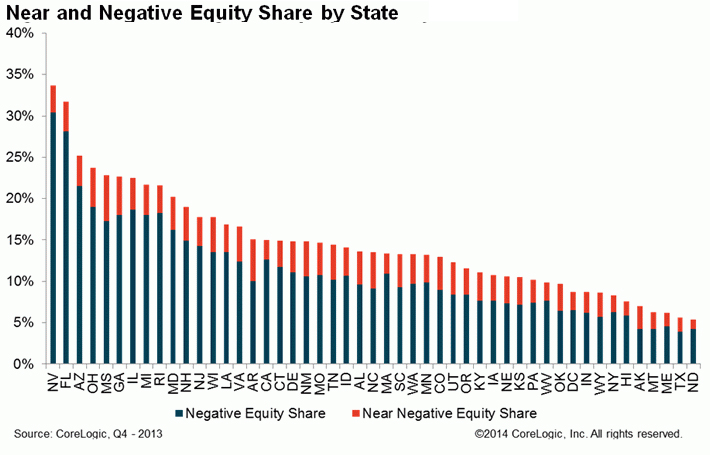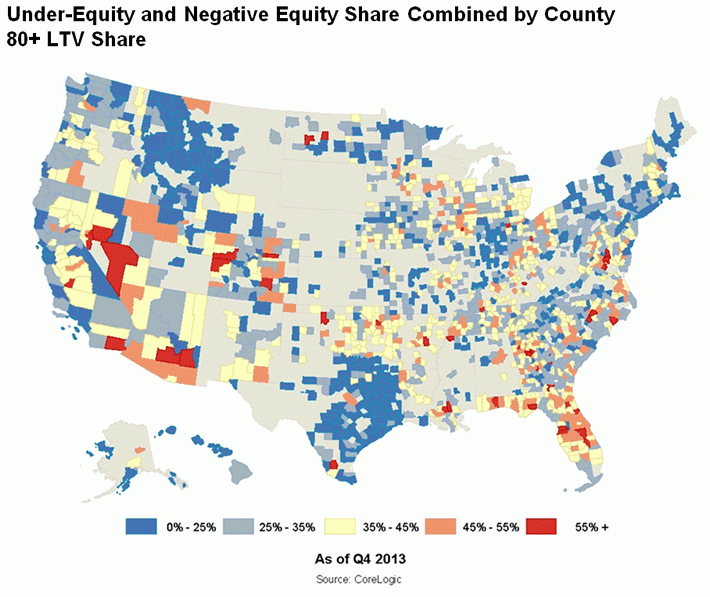The WPJ
THE WORLD PROPERTY JOURNALReal Estate Facts Not Fiction
Residential Real Estate News

Four Million U.S. Mortgaged Homes Gain Equity
Residential News » North America Residential News Edition | By Francys Vallecillo | March 6, 2014 10:03 AM ET
A total of four million U.S. homes returned to positive equity in 2013, bringing the total number of mortgaged residential properties with equity to 42.7 million, according to a report from CoreLogic.
Approximately 6.5 million homes, or 13.3 percent of all mortgaged homes, remained in negative equity at the end of 2013. Due to a small slowdown in the home price index growth rate, the negative equity share was little changed from the end of the third quarter. Negative equity -- referred to as "underwater" or "upside down" -- means borrowers owe more than their homes are worth.
"Only 14 states have a higher negative equity average than the U.S., and more states should experience improvement throughout 2014," said Anand Nallathambi, president and CEO of CoreLogic.
The national aggregate value of negative equity was $398.4 billion for the fourth quarter, compared to $401.3 billion the previous quarter, CoreLogic reports.
"The plight of the underwater borrower has improved dramatically since negative equity peaked in December 2009 when more than 12 million mortgaged homeowners were underwater," said Mark Fleming, chief economist for CoreLogic. "Over the past four years, more than 5.5 million homeowners have regained equity, reducing their risk of foreclosure and unlocking pent-up supply in the housing market."
A total of 10 million homes have less than 20 percent equity -- referred to as "under-equitied" -- and may have a difficult time obtaining new financing. In 2013, more than 1.6 million homes had less than five percent equity, which is considered near-negative equity and considered at risk if home price fall.
More from the report:
- Nevada had the highest percentage of mortgaged properties in negative equity at 30.4 percent, followed by Florida (28.1 percent), Arizona (21.5 percent), Ohio (19.0 percent) and Illinois (18.7 percent). These top five states combined account for 36.9 percent of negative equity in the United States.
- Of the 25 largest Core Based Statistical Areas (CBSAs) based on population, Orlando-Kissimmee-Sanford, Fla., had the highest percentage of mortgaged properties in negative equity at 31.5 percent, followed by Tampa-St. Petersburg-Clearwater, Fla. (30.4 percent), Phoenix-Mesa-Scottsdale, Ariz. (22.1 percent), Chicago-Naperville-Arlington Heights, Ill. (21.4 percent) and Atlanta-Sandy Springs-Roswell, Ga. (19.9 percent).
- Of the total $398 billion in negative equity, first liens without home equity loans accounted for $205 billion aggregate negative equity, while first liens with home equity loans accounted for $193 billion.
- Approximately 3.9 million upside-down borrowers hold first liens without home equity loans. The average mortgage balance for this group of borrowers is $219,000. The average underwater amount is $52,000.
- Approximately 2.6 million upside-down borrowers hold both first and second liens. The average mortgage balance for this group of borrowers is $293,000.The average underwater amount is $75,000.
- The bulk of home equity for mortgaged properties is concentrated at the high end of the housing market. For example, 92 percent of homes valued at greater than $200,000 have equity compared with 81 percent of homes valued at less than $200,000.


Sign Up Free | The WPJ Weekly Newsletter
Relevant real estate news.
Actionable market intelligence.
Right to your inbox every week.
Real Estate Listings Showcase
Related News Stories
Residential Real Estate Headlines
- More Americans Opting for Renting Over Homeownership in 2024
- BLOCKTITLE Global Property Tokenization Platform Announced
- Small Investors Quietly Reshaping the U.S. Housing Market in Late 2024
- Greater Miami Overall Residential Sales Dip 9 Percent in November
- U.S. Home Sales Enjoy Largest Annual Increase in 3 Years Post Presidential Election
- U.S. Housing Industry Reacts to the Federal Reserve's Late 2024 Rate Cut
- U.S. Home Builders Express Optimism for 2025
- Older Americans More Likely to Buy Disaster-Prone Homes
- NAR's 10 Top U.S. Housing Markets for 2025 Revealed
- U.S. Mortgage Delinquencies Continue to Rise in September
- U.S. Mortgage Rates Tick Down in Early December
- Post Trump Election, U.S. Homebuyer Sentiment Hits 3-Year High in November
- Global Listings Aims to Become the Future 'Amazon of Real Estate' Shopping Platform
- Greater Las Vegas Home Sales Jump 15 Percent in November
- Ultra Luxury Home Sales Globally Experience Slowdown in Q3
- World Property Exchange Announces Development Plan
- Hong Kong Housing Market to Reach Equilibrium in Late 2025
- Construction Job Openings in U.S. Down 40 Percent Annually in October
- U.S. Mortgage Applications Increase in Late October
- World Property Markets, World Property Media to Commence Industry Joint-Venture Funding Rounds in 2025
- New Home Sales Hit 2 Year Low in America
- U.S. Pending Home Sales Increase for Third Consecutive Month in October
- Pandemic-led Residential Rent Boom is Now Fizzling in the U.S.
- Emerging Global Real Estate Streamer WPC TV Expands Video Programming Lineup
- 1 in 5 Renters in America Entire Paycheck Used to Pay Monthly Rent in 2024
- U.S. Home Sales Jump 3.4 Percent in October
- Home Buyers Negotiation Power Grows Amid Cooling U.S. Market
- Canadian Home Sales Surge in October, Reaching a Two-Year High
- Greater Orlando Area Home Sales Continue to Slide in October
- U.S. Mortgage Credit Availability Increased in October
- U.S. Mortgage Rates Remain Stubbornly High Post Election, Rate Cuts
- Construction Input Prices Continue to Rise in October
- BETTER MLS: A New Agent and Broker Owned National Listings Platform Announced
- Home Prices Rise in 87 Percent of U.S. Metros in Q3
- Caribbean Islands Enjoying a New Era of Luxury Property Developments
- The World's First 'Global Listings Service' Announced
- Agent Commission Rates Continue to Slip Post NAR Settlement
- Market Share of First Time Home Buyers Hit Historic Low in U.S.
- Greater Palm Beach Area Residential Sales Drop 20 Percent Annually in September
- Mortgage Applications in U.S. Dip in Late October
Reader Poll
Marketplace Links
This website uses cookies to improve user experience. By using our website you consent in accordance with our Cookie Policy. Read More





